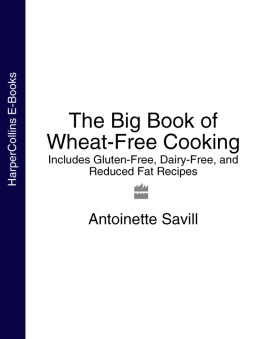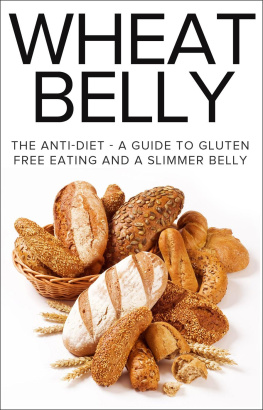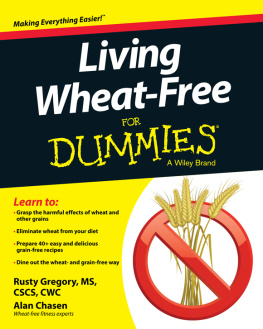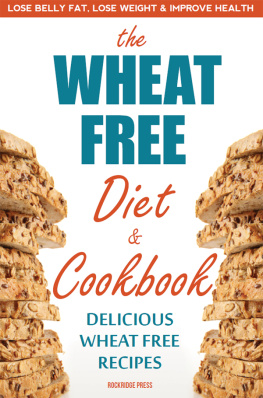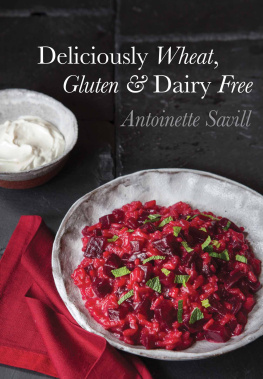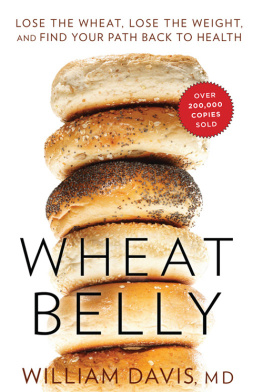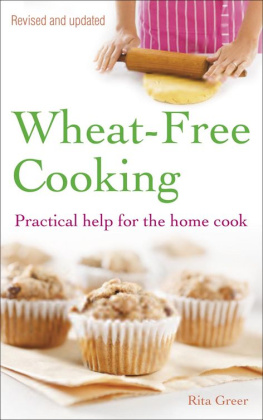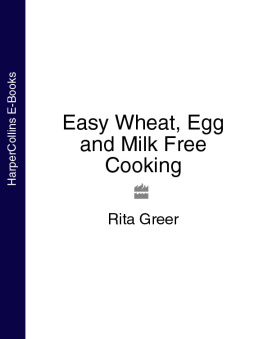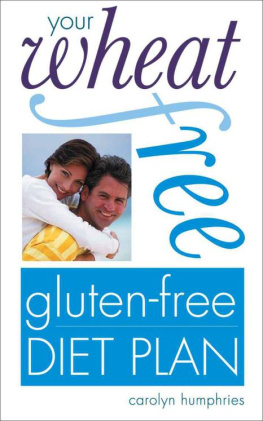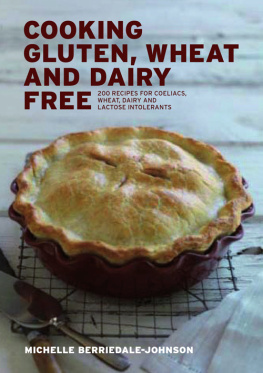The symbols shown below are used throughout the book to enable you to judge the suitability of each recipe. A wheat-free symbol is not included because every recipe is wheat free. An asterisk beside an ingredient indicates that it may contain gluten, so check and if necessary use an alternative gluten-free brand.
Note that many of the recipes that are not marked as dairy free could be easily converted to such by using dairy-free margarine instead of butter and soya milk and yogurt in place of the standard dairy product. Similarly, many of the recipes that are not marked as vegetarian could easily be converted by using vegetarian products instead of meat often you will find vegetarian options given in the introduction to the such recipes.
The buzzword for the future is wheat-watching. In countries such as the UK, Australia and the USA, the trend has already begun, with growing numbers of people avoiding wheat, either permanently or for short periods, to improve their health and energy.
However, when it comes to putting it into practice, the decision to go wheat free can be a little more difficult than one might think not just because of the countless wheat-based products such as breads, pastas, pastries, cakes and cookies that are on the market but also because so many other products may surreptitiously contain wheat. You may be surprised to find that wheat is used to bulk out or stabilize many foods. For instance, nearly all processed, frozen or canned foods contain wheat, including soups, mayonnaise, sausages and frozen French fries. In addition, many manufactured products, such as soy sauce, contain very small amounts of wheat. Such tiny quantities may not cause problems for most people but those who have a wheat allergy or coeliac disease must ensure that everything they eat is entirely wheat free.
Its all too easy to dwell on the negative effects that some foods can have on us but we mustnt forget that food can act as a very healing medicine. It is vital then that we stop and consider what we are putting into our bodies and what effect it has on us physically and emotionally before we charge gung ho round the supermarket, throwing anything in our trolley.
Thankfully shopping has become a less arduous task for wheat-watchers over recent years, as an increasing number of wheat-free ingredients and products have become available. Take a look in the well-being and organic aisles, for instance, and youll find lots of interesting new wheat-free products from all over the world. Alternatively, you can buy the foods and ingredients that you need from health food shops, by mail order or on the internet (youll find a helpful list of stockists ).
Thanks to chefs like Jamie Oliver, cooking is now tremendously popular again even amongst the young, many of whom are seeing it as cool for the first time. The TV food programs portray the fun and excitement of cooking and I want to show that cooking for food intolerance neednt be any different. The recipes in this book will ensure that cooking is an enjoyable experience no matter what your age or level of experience.
With todays fast pace of life, shared family meals have inevitably become rare. Lifestyle changes and busy schedules mean that TV dinners and the general grab and graze culture have become part of our way of looking at food and cooking it. However, I hope that the selection of quick, easy and comforting recipes in this book will encourage a return to everyone congregating in the kitchen and helping to prepare a delicious meal, as well as chatting and dining together.
My aim with this book is to provide plenty of delicious alternatives to products that normally contain wheat. You will therefore find the pages packed with wonderful breads, muffins, cakes, desserts and pies made with a wide variety of nutritious cereals such as rye, barley, oatmeal, rice, corn, millet and quinoa. And so that you can enjoy life to the full and not miss any of the normal foods that we eat on a day-to-day basis, I have also included many recipes that can be enjoyed by your family, your friends or at work those who dont suffer from intolerances wont know the difference!
Improved health is the usual objective of those cutting out wheat but it can have other advantages too. Wheat intolerance can be an important factor in a failure to shed excess weight. If you are eating a balanced diet and are in relatively good health yet still have difficulty losing weight, it may be that food intolerance is playing a part. This is because food intolerance can encourage the body to hold on to excess fluid. When the offending food is removed, weight loss often occurs. Abdominal bloating is often a sign that the digestive system is not dealing very well with a specific food and the most common food that is known to cause this problem is wheat.
The Trouble with Wheat
A large percentage of people eat too much wheat. If you think about the average daily diet, just three or four foods show up repeatedly. For example, an everyday breakfast of toast with butter and marmalade consists of wheat flour (bread), dairy (butter) and sugar (marmalade). A typical pasta salad for lunch would mean more wheat and dairy, whilst a dinner of pizza or chicken pie would again include wheat (in the pizza base or the pastry). And lets not forget snacks biscuits, doughnuts, crispbreads and bagels are all popular snacks and each one contains wheat.
Many people dont think about the constituents of their meals and imagine they are eating lots of different foods. In fact, many meals are essentially the same but are processed, assembled or cooked differently.
Variety is the spice of life and one of the core principles of a healthy diet is exactly that plenty of variety. If we eat a wheat-laden diet day in day out, year after year, its no wonder our systems become overloaded, give up the struggle and become sluggish. Our bodies need the whole spectrum of nutrients and we cannot get these if we eat the same foods repeatedly.
Wheat has a nutritious and wholesome image because it is considered to be a good source of carbohydrates and dietary fibre. However, whilst we undoubtedly need both these elements in our diet, todays wheat flour is so over processed that the end product the mass-produced bland bread that fills the supermarket shelves bears little resemblance to the kind of healthy, wholemeal bread that our grandparents ate.
Since the arrival of mass production in the 1960s, wheat-filled foods have been the fastest growing items on the supermarket shelves. They are cheap and filling which is what both the manufacturers and the majority of shoppers want but, in order to produce the vast amounts of flour needed at the right price, wheat is sprayed with insecticides and fungicides. To then turn that wheat into bread can also involve an amazing number of processes. The wheat germ (which is high in vitamin E, has many of the B vitamins and is good for us) is often removed because it can turn rancid quickly and would therefore spoil the flour faster than the manufacturers would like. To make white flour, the bran is also removed; this is the outer part of the grain, which is a good source of niacin, iron, zinc, B vitamins and fibre. They may also irradiate the wheat in order to avoid contamination by insects. Having done all this, manufacturers then sometimes use chemicals, conditioners and preservatives to improve the texture and shelf life of the end product.

